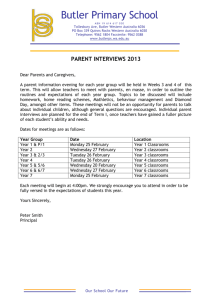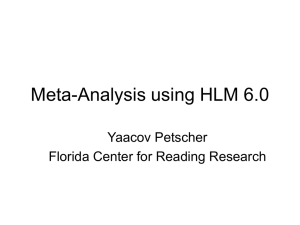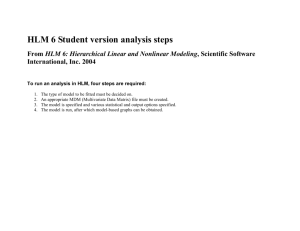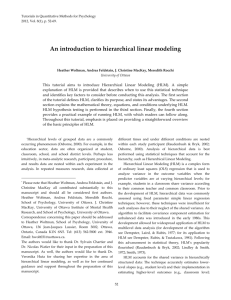variables - Flinders University
advertisement
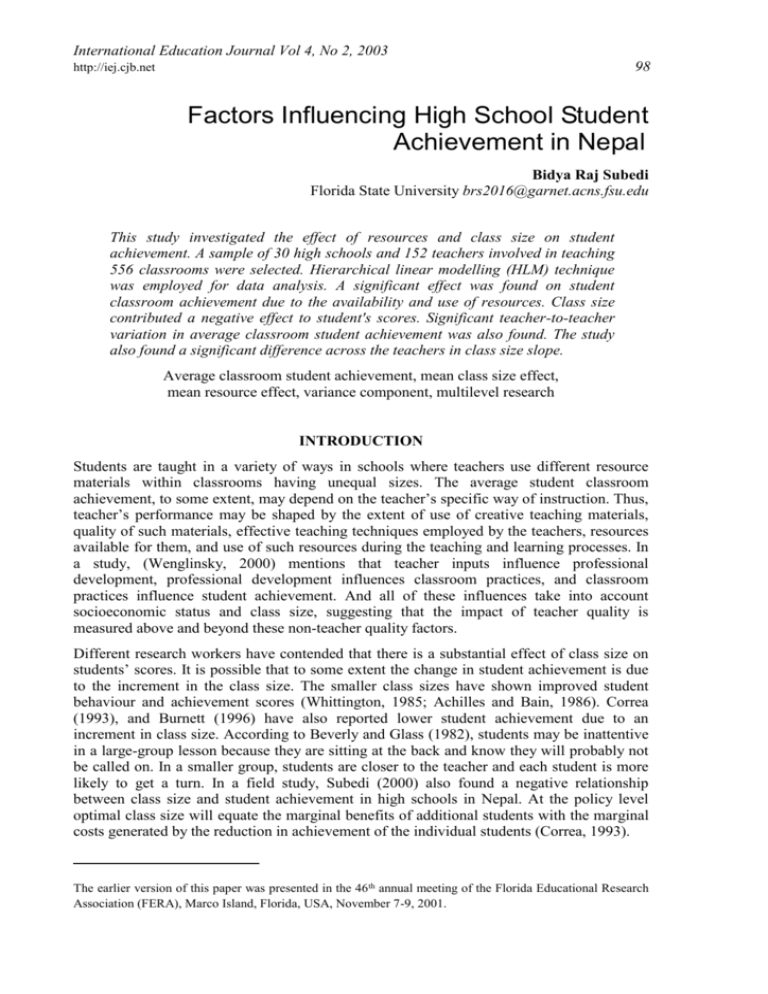
International Education Journal Vol 4, No 2, 2003 98 http://iej.cjb.net Factors Influencing High School Student Achievement in Nepal Bidya Raj Subedi Florida State University brs2016@garnet.acns.fsu.edu This study investigated the effect of resources and class size on student achievement. A sample of 30 high schools and 152 teachers involved in teaching 556 classrooms were selected. Hierarchical linear modelling (HLM) technique was employed for data analysis. A significant effect was found on student classroom achievement due to the availability and use of resources. Class size contributed a negative effect to student's scores. Significant teacher-to-teacher variation in average classroom student achievement was also found. The study also found a significant difference across the teachers in class size slope. Average classroom student achievement, mean class size effect, mean resource effect, variance component, multilevel research INTRODUCTION Students are taught in a variety of ways in schools where teachers use different resource materials within classrooms having unequal sizes. The average student classroom achievement, to some extent, may depend on the teacher’s specific way of instruction. Thus, teacher’s performance may be shaped by the extent of use of creative teaching materials, quality of such materials, effective teaching techniques employed by the teachers, resources available for them, and use of such resources during the teaching and learning processes. In a study, (Wenglinsky, 2000) mentions that teacher inputs influence professional development, professional development influences classroom practices, and classroom practices influence student achievement. And all of these influences take into account socioeconomic status and class size, suggesting that the impact of teacher quality is measured above and beyond these non-teacher quality factors. Different research workers have contended that there is a substantial effect of class size on students’ scores. It is possible that to some extent the change in student achievement is due to the increment in the class size. The smaller class sizes have shown improved student behaviour and achievement scores (Whittington, 1985; Achilles and Bain, 1986). Correa (1993), and Burnett (1996) have also reported lower student achievement due to an increment in class size. According to Beverly and Glass (1982), students may be inattentive in a large-group lesson because they are sitting at the back and know they will probably not be called on. In a smaller group, students are closer to the teacher and each student is more likely to get a turn. In a field study, Subedi (2000) also found a negative relationship between class size and student achievement in high schools in Nepal. At the policy level optimal class size will equate the marginal benefits of additional students with the marginal costs generated by the reduction in achievement of the individual students (Correa, 1993). The earlier version of this paper was presented in the 46 th annual meeting of the Florida Educational Research Association (FERA), Marco Island, Florida, USA, November 7-9, 2001. Subedi 99 An influential factor on student achievement could be the availability and the use of resources by teachers in teaching and learning activities. Simplicio (2000) suggests that teachers must be willing to utilize different methods, strategies, and approaches to instruction, and they must also be willing to change their assessment tools and evaluation criteria. There exists limited motivation for teachers to put in extra commitment as the teacher policy regarding such matters as levels of remuneration, incentive structure, career advancement remain largely unchanged (Bista, 1999). An anticipated change necessary for schools is the transition of the traditional instructional style to the innovative techniques by providing enough incentives and readily available resources for teachers. Availability of resources and use of resources by teachers in high schools was found to have a positive effect on student achievement (Subedi, 2000). Armstrong, Barbrow, Brush, and Ulintz (1999) also found a positive effect on student achievement when they provided teachers with a wider variety of computer-based resources to integrate with instructional activities. Alkadry and Nyhan (1999), in a research study conducted in Florida, found that the more resources the students were provided with in the classroom the better they improved in their achievement. To improve the learning outcomes within a school, it is imperative to educate teachers on the issue of appropriate use of instructional resources and materials. Teachers are left with a substantial responsibility to employ the instructional tools properly, however, the accessibility of the resources vary school to school. PURPOSE The purpose of this study is to explore how student classroom achievement is affected by class size, availability of resources and use of such resources by teachers in the high schools (Grades 9 and 10) in Nepal. Correa (1993) stated that increasing class size reduces student achievement and suggested further empirical study to establish a theoretical foundation for this relationship. Similarly, Turner (2000) suggested the need for further research on the relationship between school resources and student outcomes. Hierarchical linear modelling (HLM), a multilevel technique, was employed for this study since the multiple classrooms were nested within a teacher (several classes taught by the same teacher). Thus, the classroom level and the teacher level models were defined as level-1 and level-2 models respectively. Questions to be answered through this research include, how much teacher-toteacher variation in within-teacher classroom achievement remains after controlling for the effect of mean class size and mean resource?, in addition to, how much teacher-to-teacher variation in within-teacher class size effect on classroom student achievement remains after controlling for the effect of mean class size and mean resource? An important contribution of this paper from the analysis perspective is that this study has employed a newly established multilevel research technique using HLM in Nepal. Moreover, this study aggregates student level data to the class level in order to examine the effects of different teachers on the different class groups that they teach. Thus, this study employs as the lowest unit of analyses the class group and not the individual student with the student achievement data aggregated and averaged at the classroom level. As this paper is the product of an eight-month span fieldwork-based research in Nepal, the generalizations of study results will help the related authorities to improve student achievement. RESEARCH QUESTIONS Following research questions were answered through this study. 1. a) Does the mean resources of at teacher level significantly predict the average classroom achievement after controlling for mean class size? 100 b) Does the mean class size at the teacher level significantly predict the average classroom achievement after holding constant mean resources? c) How much teacher-to-teacher variation in within-teacher average classroom achievement remains after controlling for the effect of mean class size and mean resources? 2. a) Does the mean resources significantly interact with the effect of class size on average classroom achievement at classroom level after holding constant the effect of mean class size? b) Does the mean class size significantly interact with the effect of class size on average classroom achievement at the classroom level after controlling for mean resource? c) How much teacher-to-teacher variation in within-teacher class size effect on average classroom achievement remains after controlling for the effect of mean class size and mean resources? VARIABLES Outcome variable Average Classroom Student Achievement: Average classroom achievement or mean class scores were obtained from the school records based on the final examination results (2000) of Grades 9 and 10. The average classroom achievement scores were based on parallel tests and scoring schema for each subject taken by the students at Grades 9 and 10 on the high schools, where sampled teachers were teaching. Classroom level (or level-1) predictor Class size: This variable was the total number of students in the individual classrooms in which the sampled teachers were teaching. Teacher level (level-2) predictors Mean class size: This variable was the average of the class sizes that a sampled teacher was engaged in teaching. Mean Resources: This variable was defined as the average availability of resources, such as curricular and co-curricular materials, in the school for teachers and the extent of the use of resources by a specific teacher in the classroom for supporting curricular and co-curricular activities. This variable was measured based on Likert type 5-point rating scale, and was averaged for every sampled teacher. For example, the mean resource associated with a teacher who was engaged in teaching three classrooms was computed as the mean of responses from all three survey forms provided for three separate classrooms. The degree of rating was based on the ranges from strongly agree (5) to strongly disagree (1). METHODS Population and sample The target population for this study comprised all the teachers at Grades 9 and 10 of government and private high schools of Lalitpur district, Nepal. As the population units were apparently found in different geographical clusters and there was difficulty in updating the entire list of teachers from the population, multistage cluster sampling was employed to select teachers. Representative random samples were selected using random numbers Subedi 101 through this sampling procedure containing at least 20 per cent of the population members at each stage. This sampling technique was also used because of cost efficiency. The number of clusters in each stage at the time of sample selection was kept as maximum as possible. Increasing the number of clusters increases the precision of the sample and when using cluster sampling, selecting more clusters with less between-group variation improves precision (Henry, 1990). A desired validity was assured by optimizing the sample size. In total, 30 schools out of 152 (20% schools) were selected. High within-cluster heterogeneity was attempted by choosing the sample teachers of both sexes from different subject areas teaching in the classrooms of varying qualities. This helped in increasing the sample precision. After dividing the entire district into two sub-populations, the Lalitpur municipality and village development committees (VDCs) region, the Wards and VDCs were sampled randomly in the first stage. Altogether, ten VDCs (25%), and seven Wards (32%) were selected from the district. In the second stage, different schools were randomly drawn from the selected Wards and VDCs. Then, 30 high schools out of 152 (20%) were sampled. There were 16 government schools (53%) and 14 private schools (47%) selected in the sample. Four to six teachers were selected from each sample school depending on the number of high school teachers. Altogether, 152 teachers were selected excluding the position-holding teachers in order to obtain the sample. More than 30 per cent of the teachers were sampled from each school for this study. Three to four (at least 40%) classrooms were selected for each sampled teacher based on the number of classes each teacher was involved in teaching. The averages of all classroom scores were computed for those classrooms, which were nested within a particular teacher. Instruments and data collection Before designing the final survey form, a pilot survey questionnaire was developed and administered to 10 teachers in three high schools. The final survey questionnaires were prepared based on the teacher’s feedback from the pilot survey. The final survey forms were administered to the teachers based on the number of classes they were engaged in teaching. For example, if a teacher was involved in teaching four classrooms, then four forms were administered to that particular teacher in order to obtain the teacher’s response on individual classrooms. Once teachers had completed and returned the survey forms, student’s average scores (based on 1999 final exam results) for the related classrooms were computed and recorded on the teacher's forms. One hundred teachers were engaged in teaching four classes and 50 teachers were involved in teaching three classes. Participant teachers were requested to provide the factual information as fairly and independently as possible. In case of confusions on reading and interpreting the questionnaires, the researcher clarified teacher’s queries. Adequate information and instructions were provided to participant teachers prior to filling out the questionnaires. The confidentiality of the teacher's response was assured in order to preserve the ethical conditions of the survey. All possible measures were followed to increase the validity and reliability of the survey. The conditions of similar test difficulty in a particular subject for each class provided valid scores for the study. The parallel test designs were handled by the academic administration of each school under the direction of District Education Office. Comparable instructional objectives in a specific course, uniform classroom testing situations throughout the district, the same test lengths and time allocation for specific subjects, and unique government policy regarding the curricula for all the high schools were the basis for valid test scores. 102 Data analysis and model specification Hierarchical linear modelling technique, using the HLM program (Bryk, Raudenbush, & Congdon, 2000) was employed for the data analysis. However, SPSS was used to enter the survey data, and create the SSM file for HLM analysis. Initially, random effect and random coefficient models were run, and tested the significance of intercept, slope, and variance component. Several steps suggested by Tate (1998) were followed before using the teacher level predictors in the level-2 conditional model. The results showed teacher-to-teacher variation for the within-teacher models. So, within-teacher conditional models were formulated. Then, mean class size, and mean resource predictors were used as teacher level predictors in these conditional models. To answer the above research questions, the coefficients (slopes, intercepts, and variance components) of the level-1, and level-2 models were estimated. Classroom level (level-1) model The average classroom achievement for classroom i and teacher j is given by the following level-1 within-teacher model. (CLASSACH)ij = β0j + β1j (CLASSIZE)ij + rij where i = 1, 2,……,556 classrooms; and j=1, 2, ….., 152 teachers. The level-1 predictor was centred around its grand mean. Teacher level (level-2) model At level-2 the average classroom achievement, β0j, and the within-teacher effect of class size on classroom student achievement, β1j, become new outcome variables at the teacher level or for the between teacher model. β0j = γ00 + γ01 (MEANRES)j + γ02 (MEANCLAS)j + u0j β1j = γ10 + γ11 (MEANRES)j + γ12 (MEANCLAS)j +u1j For above models, j=1, 2, ….., 152 teachers; and the randomly varying slope, β1j is strictly based on the predictors: mean resource and mean class size. These level-2 predictors were centred around their grand means. It is assumed that the relationship between the predictors and the outcome variables are linear. The predictors are independent and they are measured error free. The residual terms u0j and u1j, which are normally distributed, vary randomly with means zero, and variances τ00 and τ11 respectively. The variance-covariance components represent the variability in β0j and β1j remaining after controlling for the effects of mean resource and mean class size. The further assumptions about the error terms are independence, normality and homoscedasticity. Residual versus predicted average classroom student achievement plots and normal curves provided the evidence for correct fit and normality respectively. Scatter diagram for residual versus predicted indicated the homoscedasticity. RESULTS The summarized results for final estimations of fixed effects, variance components, and reliability and average OLS coefficients for level-1 intercept and slope are shown in the Table 1, Table 2, and Table3, respectively. Subedi 103 The mean resource as a level-2 predictor significantly (p=0.005) predicted the average classroom achievement (β0j) at α = 0.05, after controlling for the effect of mean class size. Table 1. Final estimation of fixed effects Fixed Effects Coefficient Standard Error t-ratio d. f. p-value 50.24* 0.97 51.97 149 0.000 Mean resource, γ01 3.25* 1.13 2.87 149 0.005 Mean class size, γ02 0.26 0.15 1.78 149 0.075 Average within-teacher class size, γ10 -0.33* 0.09 -3.43 149 0.000 Mean resource, γ11 -0.28* 0.11 -2.65 149 0.009 Mean class size, γ12 0.002 0.01 -0.23 149 0.839 Model for teacher means Average adjusted teacher mean, γ00 Model for class size effect *significant at 5%, and 1% level of significance ** significant at 5%, level of significance There was found a high positive effect (γ01= 3.25) of mean resources on the teacher mean of classroom achievement with standard error of 1.13, and t-ratio of 2.87. In other words, the expected increase in teacher mean of classroom achievement is found to be 3.25 with respect to one unit change in mean resources. The mean class size did not have a significant effect. However, there was found to be a very small positive effect for mean class size (γ02 = 0.26) on average classroom achievement at level-2. Table 2. Final Estimation of Variance Component Random Effect Variance d. f. Chi-square p-value 112.13* 134 2140.48 0.000 Class Size Slope, U1j 0.33* 134 288.17 0.000 Level-1 effect, rij 2.59* Average Classroom Achievement, U0j *significant at 5%, and 1% level of significance A significant variability (p<0.001) across teachers in within-teacher average classroom achievement was found after controlling for mean resources and mean class size. The variance for within-teacher average classroom student achievement was found to be 112.13 with the chi-square value of 2140.48. Table 3. Reliability and average OLS coefficients for level-1 intercept and slope Random Level-1 Coefficients Reliability Average OLS Level-1 Coefficients Intercept 0.75 51.21 Slope of Class Size 0.30 -0.48 Mean resources significantly predicted (p=0.009) the within-teacher effect of class size on achievement at classroom level holding constant the effect of mean class size. There was found to be a negative effect of mean resource (γ11 = -0.28) on the slope of class size with standard error of 0.11, and t-ratio of –2.65. Significant effect (p=0.839) was not found for the mean class size in predicting the within-teacher influence of class size on achievement (with standard error of 0.01) at classroom level after controlling the effect of mean resources. However, mean class size had a very small positive effect (γ12 = 0.002) on the slope of class size at the level-1 model. In addition, a significant effect (with p=0.001, γ10 = 0.33) was found for the class size effect on classroom achievement in the teacher population. 104 The teacher-to-teacher variation in the slope of class size was found to be significant (p<0.001) after controlling the effect of mean class size and mean resources. The variance component for the effect of class size on classroom student achievement was found to be 0.33 with the chi-square value of 288.17. The variance component for the level-1 equation was found to be 2.59. The chi-square statistics for the final estimation of variance components were based on only 137 sample units that had sufficient data for computation. However, the fixed effects and variance components were based on all the 152 sample observations. The proportion of variation across teachers, also termed as the intra-class correlation, was 0.98 showing the percentage of variance in classroom student achievement between teachers. The proportion of variance explained by this model compared to the random coefficient unconditional model was 4.9 per cent; as a result of the limited number of variables in the final model the variance explained was small. The scatter plots with line graphs presented in Figure 1, Figure 2 and Figure 3, display the relationship between average classroom achievement and different predictors at the classroom and teacher levels. 80 Average Classroom Achievement 70 60 50 40 30 20 20 30 40 50 60 70 Class Size Figure 1. Scatter plots with line graph showing a negative relationship between Classroom Achievement and Class Size Teacher Average Classroom Achievement 80 70 60 50 40 30 20 0 1 2 3 4 5 6 Mean Class Resources Figure 2. Scatter plots with line graph showing a strong positive relationship between Teacher Average Classroom Achievement and Mean Class Resources at level-2 Subedi 105 Teacher Average Classroom Achievement 80 70 60 50 40 30 20 20 30 40 50 60 70 Mean Class Size Figure 3. Scatter plots with line graph showing a negative relationship between Teacher Average Classroom Achievement and Mean Class Size at level-2 DISCUSSION The resource variable at the teacher level provided a substantial contribution to the average classroom achievement. A positive effect on average classroom scores due to the availability of resources and use of such resources by teachers is worthy of discussion. Although the extent of the availability of resources for teachers may vary from school to school, the accessibility of educational materials in schools is an essential means of enlivening the academic enterprise. Teachers can maximize classroom achievement by optimizing the use of the available resources, controlling for the effect of class size at the same time. In order to increase achievement, optimizing the use of instructional materials properly by a teacher in the favour of students is more crucial than merely using such materials. For the teacher level model, the contribution of resources to class size effect was negative. This finding is important in the sense that the influence of resources within a classroom is diminished as the class size increased. As it is apparent that a teacher needs many more resources for a class with a relatively large class size, the limited availability of instructional materials and resources adversely influenced instructional processes. This kind of adverse influence of resources on class size, resulted in a negative impact on classroom achievement. A negative effect of class size on classroom achievement could be due to a crowded classroom producing a less favourable teaching and learning atmosphere. Such a situation reduces the teachers’ chance for individual student attention. In the context of Nepal, only a few high schools have predetermined their policy to admit a specific number of students per classroom or section of a class. The teaching and learning activities are the functions of student classroom admission. Possibly the larger class sizes more adversely influenced students’ achievements. The schools’ autonomy to control the internal factors for structuring optimum class size in order to increase student’s achievement is considered to be essential. Bista (1999) suggests a greater focus should be given on what happens inside the schools because local actions and factors generally determine student outcomes. A favourable class size that encourages effective teaching and learning strategies will promote an advantageous classroom environment. This, in turn, will help provide individual student care, teacherstudent interaction, and increase student achievement. 106 An important variation across the teachers in average classroom achievement was observed due to the actual differences in mean classroom achievement rather than extraneous factors. As individual teachers have varying qualities in their skill, performance, socioeconomic status, experience, age and other characteristics, they may have uniquely contributed to the student achievement. Also a teacher-to-teacher variation in the class size effect (slope) was found to be statistically significant, signifying that a true variation exists in the population of class size effects at classroom level across the teachers, after removal of the effect of resources and mean class size. CONCLUSION This study found a positive effect of resources and a negative effect of class size on average classroom achievement. A significant variation was also found across the teachers in average classroom achievement and the class size effect. Teachers who used the available resources effectively in the classroom were able to increase the achievement. The availability of resources and use of such resources by teachers contributed to an adverse impact on class size effect, and in turn, class size influenced negatively average classroom achievement. A negative effect of class size suggested that a classroom with a large number of students is likely to decrease the average level of achievement. Significant variations were found in average classroom achievement and class size effect across the teachers. The critical issue for education is how to induce the most productive use of school resources through governance, finance, and management structures that enhance student achievement (Bolton, 2000). Of course, it is more essential to arrange adequate resources including instructional materials and set up standard class sizes within the schools based on the available resources. Suggestions include leasing space, collaborative, relocating administrative space, and district-wide redistribution of space (Burnett, 1996). The generalizations of the results of the study can be extended to high school students of a similar age and grade in Nepal. Further policy researches to structure the allocation and use of available resources to specific subjects and establish an optimum class size are suggested. The school district evaluators and researchers can extend similar studies to fit higher level models using, for instance, school level predictors for a level-3 model, and district level predictors for a level-4 model. The use of important variables, such as teacher’s commitment, teacher’s socioeconomic status, and the investment in managing resources necessary to teach specific subjects would be more meaningful to predict achievement due to such factors. REFERENCES Achilles, C. M., & Bain, H. P. (1986). Interesting developments on class size. Phi Delta Kappan, 67, 662-65. Alkadry, M. G. & Nyhan, R. C. (1999). The impact of school resources on student achievement test scores. Journal of Education Finance, 25 (2), 211-28. Armstrong, J., Barbrow, D., Brush, T. A., & Ulintz, L. (1999). Design and delivery of integrated learning systems: their impact on student achievement and attitudes. Journal of Educational Computing Research, 21, 475-86. Beverly H. & Glass, G. V. (1982). School class size: research and policy. Sage Publications, CA. Bista, M. B. (1999). Some issues confronting school reform in Nepal. Educational and Development (pp. 90-98), Tribhuvan University, CERID, Kathmandu, Nepal. Subedi 107 Bolton, D. G. (2000). Critical issues in school governance, finance, and management. School Business Affairs, 66, 4-17. Bryk, A., & Congdon, R., & Raudenbush, S (2000). HLM 5: Hierarchical Linear and Nonlinear Modeling. Scientific Software International, Chicago, IL. Burnett, G. (1996). Enrollment growth and overcrowding in New York city schools. Institute for Urban and Minority Education (IUME) Briefs. New York, USA. Correa, H. (1993). An Economic Analysis of Class Size and Achievement in Education. Education Economics, 1, 129-35. Henry, G.T. (1990). Practical sampling. Sage publications, Inc. Newbury Park, CA. Simplicio, J. S. C. (2000). Teaching classroom educators: how to be more effective and creative teachers. Education, 120, 675-680. Subedi, B.R. (2000). Study of the effect of teacher level variables on student achievement in the high schools of Lalitpur district, Nepal. A Research Report. UGC, Kathmandu, Nepal. Tate, R. (1998). An Introduction to modeling outcomes in behavioural and social sciences. Second Edition. Burgess International Group, Minnesota. Turner, S. E. (2000). A comment on poor school funding, child poverty, and mathematics achievement. Educational Researcher, 29, 15-18. Wenglinsky, W. (2000). How teaching matters: bringing the classroom back into discussions of teacher quality. A Policy Report. ETS, Princeton, NJ. Whittington (1985). Effects of class size on first-grade students. Spectrum, 3, 33-39. IEJ




